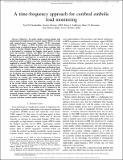| dc.contributor.author | Imaduddin, Syed M | |
| dc.contributor.author | LaRovere, Kerri L. | |
| dc.contributor.author | Kussman, Barry D. | |
| dc.contributor.author | Heldt, Thomas | |
| dc.contributor.author | Heldt, Thomas | |
| dc.date.accessioned | 2020-03-04T20:17:53Z | |
| dc.date.available | 2020-03-04T20:17:53Z | |
| dc.date.issued | 2019-07 | |
| dc.identifier.issn | 0018-9294 | |
| dc.identifier.issn | 1558-2531 | |
| dc.identifier.uri | https://hdl.handle.net/1721.1/124011 | |
| dc.description.abstract | Objective: To enable reliable cerebral embolic load monitoring from high-intensity transient signals (HITS) recorded with single-channel transcranial Doppler (TCD) ultrasound. Methods: We propose a HITS detection and characterization method using a weighted-frequency Fourier linear combiner that estimates baseline Doppler signal power. An adaptive threshold is determined by examining the Doppler signal power variance about the baseline estimate, and HITS are extracted if their Doppler power exceeds this threshold. As signatures from multiple emboli may be superimposed, we analyze the detected HITS in the time-frequency (TF) domain to segment the signals into individual emboli. A logistic regression classification approach is employed to classify HITS into emboli or artifacts. Data were collected using a commercial TCD device with emboli-detection capabilities from twelve children undergoing mechanical circulatory support or cardiac catheterization. A subset of 696 HITS were reviewed, annotated, and split into training and testing sets for developing and evaluating the HITS classification algorithm. Results: The classifier yielded 98% and 96% sensitivity for 100% specificity on training and testing data, respectively. The TF approach decomposed 38% of candidate embolic signals into two or more embolic events that ultimately account for 69% of the overall embolic counts. Our processing pipeline resulted in highly accurate emboli identification and produced emboli counts that were lower (by a median of 64%) compared to the commercial ultrasound system's estimates. Significance: Using only single-channel, single-frequency Doppler ultrasound, the proposed method enables sensitive detection and segmentation of embolic signatures. Our approach paves the way towards accurate real-time cerebral emboli monitoring. | en_US |
| dc.publisher | Institute of Electrical and Electronics Engineers (IEEE) | en_US |
| dc.relation.isversionof | http://dx.doi.org/10.1109/tbme.2019.2927709 | en_US |
| dc.rights | Creative Commons Attribution-Noncommercial-Share Alike | en_US |
| dc.rights.uri | http://creativecommons.org/licenses/by-nc-sa/4.0/ | en_US |
| dc.source | Thomas Heldt | en_US |
| dc.title | A time-frequency approach for cerebral embolic load monitoring | en_US |
| dc.type | Article | en_US |
| dc.identifier.citation | Imaduddin, Syed M. et al. "A time-frequency approach for cerebral embolic load monitoring." IEEE Transactions on Biomedical Engineering (July 2019) © 2019 IEEE | en_US |
| dc.contributor.department | Massachusetts Institute of Technology. Department of Electrical Engineering and Computer Science | en_US |
| dc.relation.journal | IEEE Transactions on Biomedical Engineering | en_US |
| dc.eprint.version | Author's final manuscript | en_US |
| dc.type.uri | http://purl.org/eprint/type/JournalArticle | en_US |
| eprint.status | http://purl.org/eprint/status/PeerReviewed | en_US |
| dspace.date.submission | 2019-07-12T00:13:09Z | |
| mit.metadata.status | Complete | |
